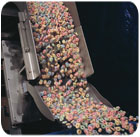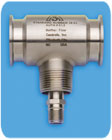
The CentriFlow system measures mass flow of solids by sensing the force required to bend the path of flowing particles into a curve. Source: Eastern Instruments.
A processing line may use magmeters or ultrasonic meters for measuring liquids. Coriolis is frequently the choice when mass flow is important. Dry ingredients may be measured by impact meters or, when greater accuracy is needed, something like Eastern Instruments' CentriFlow system, which measures mass flow by sensing the force required to bend the path of flowing particles into a curve. When it's only necessary to sense if dry product is actually flowing, Monitor Technology LLC has a new non-contact microwave unit.
A food plant's utility area often uses vortex meters for steam, thermal mass flowmeters for combustion control in boilers, and differential pressure meters for natural gas flow.
Differential pressure (dp) meters have a large installed base in general industry and in the utility side of food plants, but not in the processing end. They're difficult to CIP (clean-in-place), says Ron Pozarski, product manager for food, beverage and life sciences, Rosemount, and they're not as inexpensive as many people think. Between the transmitter, valves, pipes and assembly, the installed cost of differential dp "is actually higher than mag and vortex, but a little bit cheaper than Coriolis," he says.
For a long time vortex meters experienced slow growth, they were primarily used for monitoring steam flow because of their range and resistance to high temperatures and high pressures. Vortex meter sales are now poised for increased growth, according to the 2005 Flow Research market study "The World Market for Vortex Flowmeters, 3rd Edition," but much of that is attributable to changes in petroleum industry standards. However, the study notes, vortex meter manufacturers have made significant progress in reducing the susceptibility of their products to interference from vibration. Perhaps they will find more use in food plants some day.
Transit time and Doppler ultrasonic flowmeters are used in steam sterilization and CIP and SIP optimization. Clamp-on ultrasonic flowmeters have the advantage that they have no physical contact with product.
A 2004 study by Flow Research reports that magnetic flowmeters (magmeters) had the fastest growth rate of any flowmeter type. They're growing in the food industry as well, says Jesse Yoder, president, Flow Research. "They're highly reliable [and] they're very well designed for sanitary applications due to the lining possibilities."
The other fast grower is Coriolis, he adds. Like the magmeter, it offers reliability and accuracy, with Coriolis especially known for accuracy.
One thing that we are not seeing in flowmeters is radically new technology, says Bob Ksiazek, product manager, flow, Anderson Instrument Co. And even if it appeared, says Jonathan Fiedler, product specialist with Krohne, the food industry would be slow to adopt it. "They've been stuck in very simple processing techniques," he says.

Micro Motion F-Series Coriolis meters have ±0.10% mass flow accuracy, ±0.15% volume accuracy, ±0.50% gas flow accuracy and ±0.001 g/cc density accuracy. Source: Micro Motion.
Reliability and intelligence
As raw material and energy costs keep rising and mega-retailers increase price pressures, food and beverage companies, says Fiedler, are learning that "paying a bit more attention to process control can pay off in two, three and four-fold improvements in quality and productivity."According to John Martin, manager of food & beverage marketing, Micro Motion, flowmeters are reliable, more repeatable and maintenance-free. Users want flowmeters that don't break, "that will churn away without having to be recalibrated and reworked," Martin says. "They are looking for flowmeters that can reduce cleaning time, are CIP-able and will help reduce downtime, whether it's scheduled or unscheduled."
This has resulted, says Pozarski, in a move away from mechanical meters, that can wear or shift over time, to electronic meters with minimal or no moving parts.
Users also want technical support, says Yoder. They want meters that are easy to calibrate and can perform their own diagnostics.
According to Pozarski, food makers need verification and in situ validation. In brewing applications, for example, verification requires taking the meter out of the line and transporting it to a shop for testing. This requires shutting down production or installing a spare device. "Either way it's a disruption," he says.
A meter that can diagnose itself at the push of a button-or better still, by remote command-eliminates that disruption. Not long ago, Pozarski says, "all they could do was say, ‘I've done an electrical check and checked my memory, and I don't see any obvious problems.'" But today's meters provide comprehensive reports. "Now the devices can self-test, Pozarski says, "and they can come back and say, ‘I checked the electronics, I checked the calibration. I introduced a sample signal; my transmitter is working correctly. Here is how far it's off from its original calibration. I checked all the electrical functions of the flow tube. This is where it is compared to the original installed information. I am well within spec. I'm OK.'"

A Rosemount 8721 sanitary magmeter measures flow from a separator at a cheese plant in South Dakota. A 3-51S pressure transmitter is to the left. Source: Rosemount.
Going digital
Having up-to-date diagnostic information on flowmeters, as well as other equipment, can improve productivity and help avoid downtime, which makes digital communications very attractive. The question is which of the available protocols to use. While FOUNDATION fieldbus, DeviceNet, Profibus and other all-digital protocols are attractive, the majority of device communications in the food and beverage industry continues to be carried on HART."I think this migration to fieldbus is occurring," says Yoder, "but...much more slowly than people anticipated." HART provides almost as much information as does an all-digital protocol, and makes use of existing infrastructure, requiring no additional cabling or changes to process equipment.
"If you already have two-wire and can run on a HART, you can do probably 90 percent of what a fieldbus can do," says Bob Carrell, president, Hoffer Flow Controls. HART also delays having to look at an entire installation from a systems point of view, says Pozarski. There are a lot of instruments purchased as part of equipment. "Buying from two or three vendors," he says, "can make it difficult to move the control blocks to different locations."
Yet the all-digital protocols have some important advantages. They're fast, they provide a wealth of information, and they allow function block programming within individual instruments, which makes it possible to distribute control functions into the field.
Not everyone thinks this is necessarily a good idea. "I don't think clients like combining too much into one," says Fiedler. "If your device goes, the rest of your control goes. I think there's some anxiety there. A lot of safety has to be built in."
The slowness of the move to FOUNDATION fieldbus or Profibus may create an opportunity for another system. "I've heard a lot of users say Ethernet is coming," says Martin. "They think that it is potentially a very useful protocol down the road."
Keeping up with regulations
There haven't been many changes in US regulations affecting flowmeters since revisions to the 3A standards a few years ago, and, says Carrell, all manufacturers have (or should) have implemented it by now.That's a good thing, says Pozarski, because it may eliminate some marginal players. Before the revisions, manufacturers would self-certify their products, he says, and "some companies allowed themselves to sign off as a 3A product when really they didn't meet all the intent."
Now that third-party certification is required, he continues, "a lot of those products have to go through third-party testing and they're being pulled." He thinks this will have a positive effect on the industry.
Pozarski says another set of regulations is beginning to get more attention in the US. The European Hygienic Equipment Design Group (EHEDG) standards are similar to the 3A standards, says Pozarski, and international companies are asking vendors to meet both 3A and EHEDG.

The IZML magnetic flowmeter is aimed at applications ranging from beer to peanut butter. It meets all USDA standards and is 3A compliant. Source: Anderson Instrument Co.
Measuring the right variable
Many flowmeters are inferential-meaning an instrument measures velocity and infers volume from geometric considerations. It may then infer mass, perhaps based on a temperature reading or an assumed density value.Makers of Coriolis meters like to point out that their instruments can measure directly what others only infer. Why use a magmeter to measure milk, for instance, asks Pozarski. "Magmeters measure volume, and then they do an internal calculation that converts volume to pounds based on standard weight," he says. But "standard weight changes from cow to cow, from farm to farm, from season to season," which can become important to a company trying to manage weight loss.
"In the case of sugar," says Ksiazek, "you need to know how much, but you also need to know what the concentration or what the density of the sugar is to know how sweet it is." In fact, says Martin, "we have companies that actually batch based on concentration."
A Coriolis meter can replace a truck scale, Martin continues. Instead of weighing a tank truck before and after delivery, users should measure the actual mass of product as it's delivered.
Coriolis meters can also speed up batch processing. Processors are "going from load cell sequential batching to Coriolis flowmeters for simultaneous batching of ingredients, adding three or four ingredients simultaneously, just to increase throughput," says Martin. "They can get a couple of extra batches a day through the mixing process."

The 3A Sanitary Flowmeter meets 3A Sanitary Standard 28-03 and provides an accuracy of ±0.5% or better. Source: Hoffer Flow Controls.
The basic technology of flow measurement changes slowly and the food industry has reason to stay with what works. But food industry economic realities are forcing manufacturers to take a much closer look at processing lines in order to reap what they flow.
For more information
Bob Carrell, Hoffer Flow Controls, 800-628-4584 x219,
bcarrell@hofferflow.com
Bob Ksiazek, Anderson Instrument Co., 800-833-0081 Ext. 208,
bksiazek@andinst.com
Jesse Yoder, Flow Research, 781-245-3200,
jesse@flowresearch.com
Joe Lewis, Monitor Technologies LLC,
jlewis@monitortech.com, 630-365-9403
John Martin, Micro Motion, 303-530-8450,
john.martin@emersonprocess.com
Jonathan Fiedler, Krohne, 978-239-9114,
fiedler@krohne.com
Ron Pozarski, Rosemount, 952-828-3434,
ron.pozarski@emersonprocess.com
Jillian Craig, Eastern Instruments, (910) 392-2490,
info@easterninstruments.com